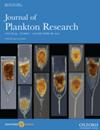Elemental composition and stoichiometry of krill and salps
IF 2
3区 环境科学与生态学
Q2 MARINE & FRESHWATER BIOLOGY
引用次数: 0
Abstract
Krill and salps play a pivotal role in marine food webs and ocean biogeochemistry, yet little is known about their stoichiometry, which is crucial for our understanding of the consequences of key grazer population shifts for ecosystem functioning. To assess differences in stoichiometric requirements, we compared the elemental composition of carbon (C), nitrogen (N) and phosphorus (P) in body tissue and gut content of Euphausia superba and Salpa thompsoni collected along the Northern Antarctic Peninsula and conducted a systematic literature review on the stoichiometry of 33 euphausiid and 19 salp species. Our data revealed significantly lower body C:P and N:P ratios but higher gut content N:P in S. thompsoni compared with E. superba, suggesting higher P uptake. In contrast, literature data showed higher C:N, C:P and N:P ratios in salps, potentially indicating lower nutrient demand compared with krill. However, literature data exhibited high intra- and interspecific variability potentially driven by organism size, seasonal or latitudinal variations, emphasizing that nutritional requirements are not only related to the target species, but also to its habitat. Our study provides valuable stoichiometric information for future experimental and modeling studies, fostering our ability to predict the future role of krill and salps for ocean biogeochemistry.磷虾和海带的元素组成和化学计量学
磷虾和沙鱼在海洋食物网和海洋生物地球化学中发挥着关键作用,但人们对它们的化学计量知之甚少,这对于我们理解关键食草动物种群变化对生态系统功能的影响至关重要。为了评估化学计量需求的差异,我们比较了在南极半岛北部采集的超级大马哈和汤普森萨尔帕的身体组织中碳(C)、氮(N)和磷(P)的元素组成和肠道含量,并对33种超级大马哈和19种萨尔帕物种的化学计量进行了系统的文献综述。我们的数据显示,与超级稻相比,汤普森的体内C:P和N:P比率显著较低,但肠道含量N:P较高,这表明磷的吸收较高。相比之下,文献数据显示,三文鱼的C:N、C:P和N:P比例较高,这可能表明与磷虾相比,其营养需求较低。然而,文献数据显示,生物体大小、季节或纬度变化可能会导致种内和种间的高度变异,强调营养需求不仅与目标物种有关,还与其栖息地有关。我们的研究为未来的实验和建模研究提供了有价值的化学计量信息,增强了我们预测磷虾和磷虾在海洋生物地球化学中未来作用的能力。
本文章由计算机程序翻译,如有差异,请以英文原文为准。
求助全文
约1分钟内获得全文
求助全文
来源期刊

Journal of Plankton Research
生物-海洋学
CiteScore
3.50
自引率
9.50%
发文量
65
审稿时长
1 months
期刊介绍:
Journal of Plankton Research publishes innovative papers that significantly advance the field of plankton research, and in particular, our understanding of plankton dynamics.
 求助内容:
求助内容: 应助结果提醒方式:
应助结果提醒方式:


